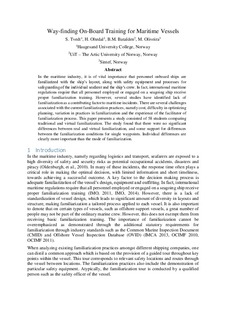| dc.contributor.author | Tvedt, Sturle Danielsen | |
| dc.contributor.author | Oltedal, Helle Asgjerd | |
| dc.contributor.author | Batalden, Bjørn-Morten | |
| dc.contributor.author | Oliveira, Manuel Fradinho | |
| dc.date.accessioned | 2019-03-26T08:04:27Z | |
| dc.date.available | 2019-03-26T08:04:27Z | |
| dc.date.created | 2018-06-08T10:29:21Z | |
| dc.date.issued | 2018 | |
| dc.identifier.citation | Tvedt, S., Oltedal, H., Batalden, B. M., & Oliveira, M. (2018). Way-finding on-board training for maritime vessels. Entertainment Computing, 26, 30-40. | nb_NO |
| dc.identifier.issn | 1875-9521 | |
| dc.identifier.uri | http://hdl.handle.net/11250/2591703 | |
| dc.description | Author's accepted manuscript (post-print). | |
| dc.description | Available: 2020-01-03. | |
| dc.description.abstract | In the maritime industry, it is of vital importance that personnel onboard ships are familiarized with the ship’s layout, along with safety equipment and processes for safeguarding of the individual seafarer and the ship’s crew. In fact, international maritime regulations require that all personnel employed or engaged on a seagoing ship receive proper familiarization training. However, several studies have identified lack of familiarization as a contributing factor to maritime incidents. There are several challenges associated with the current familiarization practices: cost, difficulty in optimizing planning, variation in practices in familiarization and the experience of the facilitator of familiarization process. This paper presents a study consisting of 58 students comparing traditional and virtual familiarization. No overall difference was found between real and virtual familiarization overall, although some differences were found for single waypoints. Individual differences were more important than treatment, indicating that virtual familiarization can perform on par with traditional approaches. | nb_NO |
| dc.language.iso | eng | nb_NO |
| dc.publisher | Elsevier | nb_NO |
| dc.rights | Attribution-NonCommercial-NoDerivatives 4.0 Internasjonal | * |
| dc.rights.uri | http://creativecommons.org/licenses/by-nc-nd/4.0/deed.no | * |
| dc.title | Way-finding on-board training for maritime vessels | nb_NO |
| dc.type | Journal article | nb_NO |
| dc.type | Peer reviewed | nb_NO |
| dc.description.version | acceptedVersion | nb_NO |
| dc.subject.nsi | VDP::Teknologi: 500::Marin teknologi: 580::Skipsteknologi: 582 | nb_NO |
| dc.subject.nsi | VDP::Matematikk og Naturvitenskap: 400::Informasjons- og kommunikasjonsvitenskap: 420::Simulering, visualisering, signalbehandling, bildeanalyse: 429 | nb_NO |
| dc.source.pagenumber | 30-40 | nb_NO |
| dc.source.volume | 26 | nb_NO |
| dc.source.journal | Entertainment Computing | nb_NO |
| dc.identifier.doi | 10.1016/j.entcom.2018.01.002 | |
| dc.identifier.cristin | 1589907 | |
| cristin.unitcode | 203,13,3,0 | |
| cristin.unitcode | 203,13,1,0 | |
| cristin.unitname | Institutt for økonomi og administrasjon | |
| cristin.unitname | Institutt for maritime studium | |
| cristin.ispublished | true | |
| cristin.fulltext | postprint | |
| cristin.qualitycode | 1 | |
| dc.date.embargoenddate | 2020-01-03 | |

